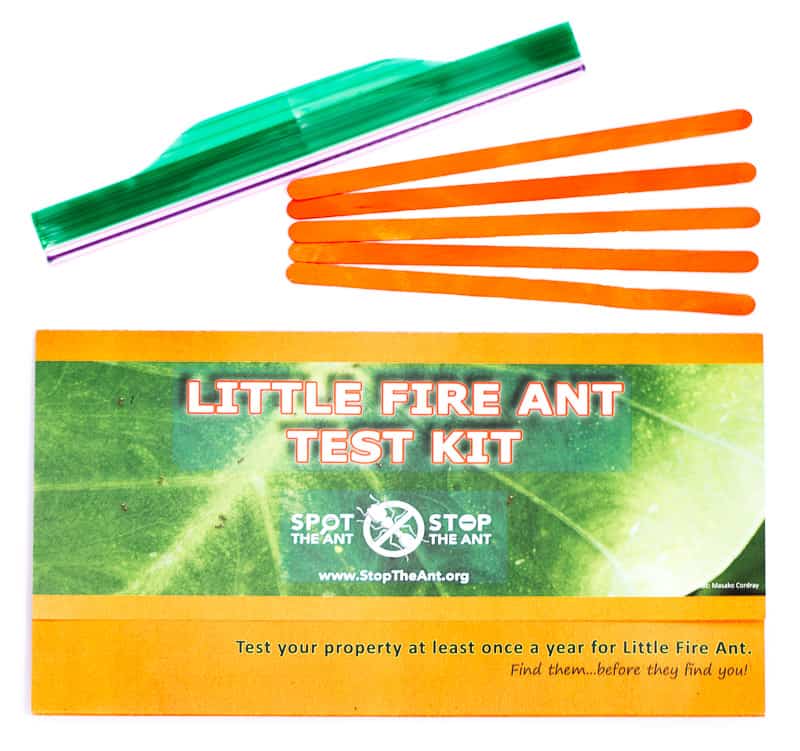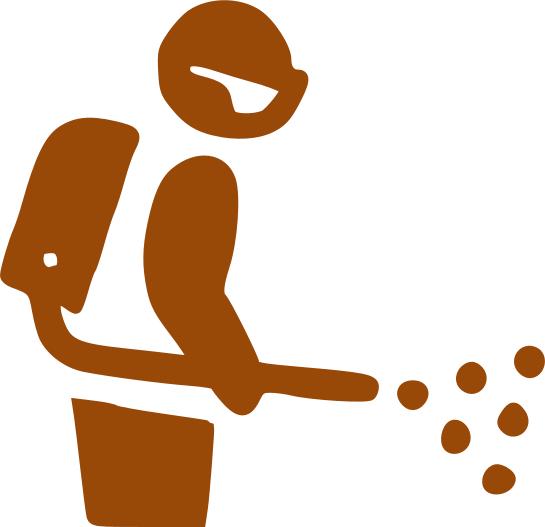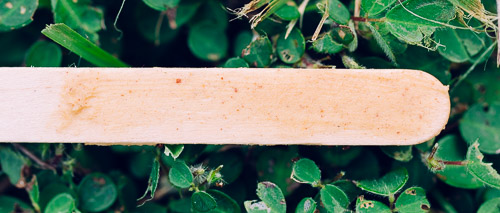Surveying for Little Fire Ants
Video: How to
survey for LFA
Short, 3-minute video with step-by-step instructions on how to test your property for Little Fire Ants (LFA).
Request a FREE Test Kit

Have you tested your property
for Little Fire Ants?
Just because you haven’t seen Little Fire Ants (LFA) in your yard, it doesn’t mean they are not lurking about. LFA are so tiny they can go undetected on your property for years until their numbers are well established.
Testing is quick and easy! Surveys should be conducted every 4-6 months. The sooner you detect them, the easier and cheaper it will be to control them!
What’s included in the kit:
- Instructions on how to collect ant specimens
- 5 sticks for bait placement
- Envelope addressed to your island’s ant ID specialists to send your specimens
- Ziploc bag for freezing ants
Why should you survey?

Determine if LFA are present
You can’t be certain your property is LFA free until you conduct a survey. LFA are so tiny they can go undetected on your property for years until their numbers are well established. Surveys should be conducted every 4-6 months. Early detection of LFA significantly improves the probability that the infestation can be managed at a low cost.

Identify the extent of an infestation
Often people will make the mistake of only treating areas on their property where they have been stung by LFA. It’s always best to survey your property and identify the extent of the infestation you need to treat. Many times, this will be your entire house lot.

Determine if treatments are working
It’s a good idea to survey your property 6 months after your first treatment to get a reading of how well your treatments are working, because there are several variables (weather, age of bait, waiting too long between treatments, etc.) that can inhibit the effectiveness of your treatments. If at the 6 month survey you do not notice a reduction in the population of LFA, you can contact us to troubleshoot.

Identify hot spots
After treating your property for 12 months, survey your property to identify the “hot spots” where LFA are still present. This allows you to concentrate your efforts on only treating the “hot spots” instead of continuing to treat a larger area, saving you money and time.

Bringing in new plants/materials
Remember, LFA are “hitch-hiker” ants. Prevention is the first line of defense against LFA. Check any “high risk” items likely to harbor LFA that you bring to your home, such as: potted plants, cuttings, foliage, soil, mulch, and landscaping materials using the peanut butter stick method below. Before bringing in any new materials to your home, designate a site on your property as a quarantine area where new materials can be stored for a few weeks. This quarantine area should be well away from any vegetation, so the LFA can’t sneak out and infest your property. As an extra precaution, you can spray a residual pesticide barrier as a perimeter around the quarantine area. Some people spray the entire area under the pile for good measure. Now you have a safe place to store the material while you check for LFA.
What You Need

creamy Peanut Butter
LFA seem to prefer the cheaper brands of peanut butter best

Chopsticks (cut in half), Popsicle sticks, or coffee stirrers

Ziploc
bags

Bright-colored spray paint (OPTIONAL)
fluorescent pink or
orange is best
How to Survey
Step 1

Smear a very thin layer of peanut butter on chopsticks, popsicle sticks, or coffee stirrers. It’s helpful to spray paint the sticks a bright color to make them easier to find again.
Step 2

Place sticks in shady, moist places on the ground and in trees every 15-30ft around your yard.
Step 3

After an hour, carefully check the sticks for ants. If you see small, orange ants on the stick (like the image above), place them in a Ziploc bag. Freeze the bags for 24 hours to kill the ants.
Step 4

Mail ant samples to our office for identification. If you are mailing ant samples with sticks in the bag, please remember the postage will be higher than a standard letter. If you want to save on postage, you can shake the ants off the stick into the bag. Please don’t forget to include your contact info!
You can also drop off your ant samples in person at either our Hilo or Kona office. If you plan to visit the Hilo office, please call us at (808) 315-5656 in advance to confirm that staff will be available to assist you.
Tips for a Better Survey
- Always place sticks out of the sun
LFA like shady, moist places so avoid placing sticks in the direct sunlight. Also, think ahead to where the sun will be in an hour when you collect the sticks. - Survey your palms and bananas
These plants are without question the favorite plants for LFA, because they provide two things they need the most: food and shelter. The best location to place a stick is where older leaves join onto the stem, as well as in the leaf litter at the base of the plant. - Survey when LFA are most active
The best time to do a survey is in the morning or afternoon when LFA are typically most active. Avoid surveying in the middle of the day when it is very hot. - Divide larger properties into sections
To make it easier to narrow down the location of your LFA infestation on a larger property, you can divide your property into sections and place all the chopsticks from one section into the same Ziploc bag. Don’t forget to write the location onto each Ziploc bag. - Submit your ants for identification
There are several other small, orange/red ants here in Hawaiʻi that superficially resemble LFA. Determination requires the use of a high-powered microscope with at least 40x magnification and a qualified person to identify the specimen. If you suspect you have LFA, please bring in or mail your ants to our office for verification. You don’t want to invest time and money treating for LFA until you are 100% certain you have them.

Your Guide to How to Survey
for Little Fire Ants
A PDF on how to survey is also available for download.

